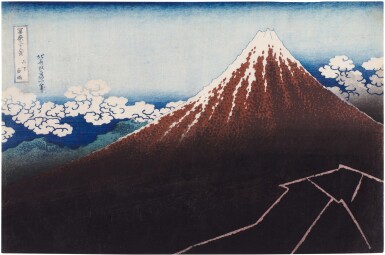
Katsushika Hokusai (1760-1849) | Sudden Rain beneath the Summit (Sanka haku-u) | Edo period, 19th century
Lot Closed
July 21, 01:34 PM GMT
Estimate
300,000 - 400,000 GBP
Lot Details
Description
Katsushika Hokusai (1760-1849)
Sudden Rain beneath the Summit (Sanka haku-u)
Edo period, 19th century
woodblock print, from the series Thirty-six Views of Mount Fuji (Fugaku sanjurokkei), signed Hokusai aratame Iitsu hitsu (Brush of Iitsu, changed from Hokusai), published by Nishimuraya Yohachi (Eijudo), late 1831
Horizontal oban: 24.1 x 36.5 cm., 9½ x 14⅜ in.
One of Hokusai’s most celebrated designs, the artist envisions the western side of Mount Fuji. Often regarded as the ‘back view’ of the mountain, it appears to be a late summer’s afternoon. Bands of clouds creep around the rear of the mountain and a verdant ridge only just peaks above the dramatic slope. The white rain, or hakuu of the Japanese title means a sudden downpour, but apart from the subtle black bokashi [gradation] used within the rightmost cloud to suggest amassing rainclouds, the summer sky of the upper half of the composition contrasts acutely with the lower half. Here, the darkness of a gathering storm entirely blackens the side and base of the mountain and a crackle of lightning peals across the lower right, signaling the sudden summer storm. Yet, in its monumentality Mount Fuji towers above the elements unperturbed.
With its economic rendering of the asymmetrical composition, as well as the steep rise of the volcanic cone, it is equally as lofty in design as as South Wind, Clear Weather (Gaifu kaisei), also known as Red Fuji (see Lot 32). In fact, Sudden Rain beneath the Summit can be described as the antithesis to South Wind, Clear Weather, and it has been proposed that Hokusai’s intentions may have been to set up a series of contrasts between the two designs: front, back; morning, evening; fair weather, storm.1 Furthermore, their conscious pairing may also be indicated by their titles, with one referring to rain and the other to wind; both being elements which manifested themselves in the form of gods, and which were most famously depicted by Tawaraya Sotatsu (1570-1643) in his pair of two-panel folding Wind God and Thunder God Screens (Fujin Raijin zu byobu) executed in the early seventeenth century.
Together with Under the Wave off Kanagawa (Kanagawa-oki nami-ura), also known as The Great Wave (see Lot 31) and South Wind, Clear Weather it forms a trio of masterpieces from the series.
It has been estimated that as many as 8,000 impressions of each design of the series Thirty-Six Views of Mount Fuji were printed over the years, however many surviving impressions are late or faded.2 Over the course of printing this number of impressions, the woodblocks would wear, resulting in impressions that have visible wear in the printed outlines. Also as printing progressed less attention would be given to the process, resulting in a loss of subtlety present in early impressions.
The present lot is the earliest type of impression of Sudden Rain beneath the Summit, characterised by two reddish dots below the peak (later printings have only one dot), a blue sky with the clouds fully visible, and a thin lightning flash when compared with even slightly later printings.3 The fine quality of this impression is also evident from the crisp outlines and delicate bokashi shading which decline in later printings.
1. Timothy Clark, Hokusai: Beyond the Great Wave, (London, 2017), p. 126, pl. 54.
2. Ibid., pg. 123.
3. For a full explanation of the changes over the various impressions of Sudden Rain beneath the Summit, see Andreas Marks, Hokusai: Thirty-six Views of Mount Fuji, (Koln, 2021), p.163
You May Also Like





